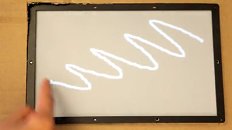- Joined
- Oct 9, 2007
- Messages
- 47,244 (7.54/day)
- Location
- Hyderabad, India
| System Name | RBMK-1000 |
|---|---|
| Processor | AMD Ryzen 7 5700G |
| Motherboard | ASUS ROG Strix B450-E Gaming |
| Cooling | DeepCool Gammax L240 V2 |
| Memory | 2x 8GB G.Skill Sniper X |
| Video Card(s) | Palit GeForce RTX 2080 SUPER GameRock |
| Storage | Western Digital Black NVMe 512GB |
| Display(s) | BenQ 1440p 60 Hz 27-inch |
| Case | Corsair Carbide 100R |
| Audio Device(s) | ASUS SupremeFX S1220A |
| Power Supply | Cooler Master MWE Gold 650W |
| Mouse | ASUS ROG Strix Impact |
| Keyboard | Gamdias Hermes E2 |
| Software | Windows 11 Pro |
Finger-lag is one specification buyers of touchscreen devices such as tablets and smartphones don't pay too much attention to. Finger-lag is a phenomenon when it takes a short but noticeable amount of time for a touchscreen-enabled device to respond to a touch interaction in progress (such as drawing something in a paint program, dragging an object around, etc.). Microsoft sought to address the issue by developing a new touchscreen technology that reduces latency to 1 ms, delivering much more responsive touchscreen interactions. Paul Dietz at Microsoft's Applied Science division has managed to lower touchscreen latency to 1 ms, in comparison, touchscreens in the market typically have 100 ms. The technology can also be applied to high-precision stylus-based devices such as graphics tablets, where touch-latency can affect the quality of graphics work.


A video of the technology at work follows.
View at TechPowerUp Main Site


A video of the technology at work follows.
View at TechPowerUp Main Site
Last edited by a moderator:








